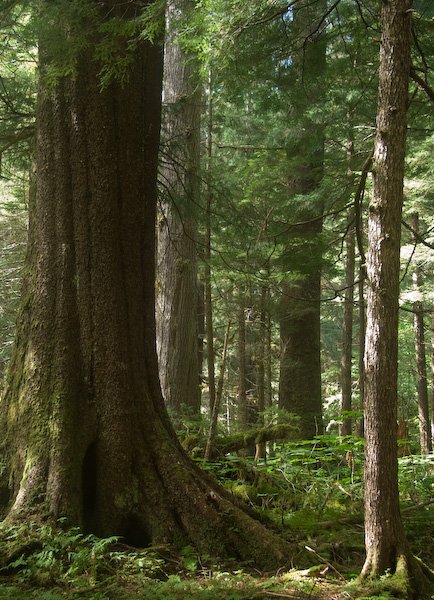I had the opportunity to get up Indian River Valley with Scott Harris and Richard Carstensen. Richard is a naturalist who lives in Juneau, but has done work all over Southeast Alaska. He made the comment that to be a naturalist, you must be a generalist in subject matter, but a specialist in place. I thought that was a pretty good way of describing my goals as a naturalist.
Later in the day there was a gathering of (former) SJ faculty, so we borrowed a friend’s car. We ended up being a bit early, so we drove out to Starrigavan and back, but did not get out to look around.
Weather: It was mostly sunny, on the hike and around town. However, when we drove out to Starrigavan, there were pretty good rain showers falling. It made for a very bright rainbow, but of course I did not have my camera. There was a nice sunset this evening, as well.
Birds: I think I heard a Red-tail Hawk up Indian River valley. I heard a call like a strange eagle (and no yodeling). That’s what turned out to be the hawk last time, so I figured that’s what it was this time. I did not see it, however.
Other Notes: There was plenty of bear sign up in the Middle Sister muskegs. There was fresh hair on the rub trees we passed. I also saw fresh tracks in the mud, including some the size of a cub. We did not actually see any bears, however.
There was a place along a cut bank where a fine sediment deposit was exposed. The deer seemed to favor this over the nearby riverbed cobbles. They appeared to have dug out places in the sediment. Richard thought it might be used as a mineral lick. It was not immediately clear what the source of the sediment was. It was the color of ash, and a closer look suggested it had been deposited by the river.
Another interesting thing we observed were ancient channels that appeared to have been inactive for quite some time. I had noticed these before, but never really thought about them much. Richard suggested they might have formed during the little ice age. It was interesting to listen to him talk about how waterflow (both current and past) effect how the forests grow.
Though I was nervous about finding it (after I took a much different route than I have previously), we did get to the big hemlock and used some fancier equipment to measure it. We took the circumference at the standard 4.5 feet off the ground (instead of doing the diameter as high as we could reach, as had been done previously when I was involved in measuring it). That added several inches to the circumference. However, using a laser distance measuring tool and the inclinometer from a couple of different locations, we found the height to be 156 or so feet. This was several feet shorter than we had estimated previously. Our canopy measurements were quite similar to previous measurements. All told, our score came out to 535. The current record holding tree (on the Olympic Penninsula in Washington) is 549.
It was an enjoyable hike with Scott and Richard. It was not something I had thought about before, but as I was talking with Richard, I realized that a significant majority of my woods experience is with the Indian River watershed (including ridges above it). As such, I really don’t know how it compares to other locations in Southeast. What’s ‘normal’ for Indian River may be unsual elsewhere, and vice versa. It was interesting to have his perspective informed by the time he has spent in the woods throughout Southeast.



Super photo! How big were these trees??
Carolyn H.
Thanks! I have added a couple of other versions of the scene with a person (Richard Carstensen) included that give a little better idea of the size (click on thumbnails for larger view). By West Coast big tree standards, they were not huge, but they were pretty good sized.
I hadn’t realized it was so close to “the” record.
Matt,
Thanks for posting more of the photos. Those trees are pretty big!!
Carolyn H.